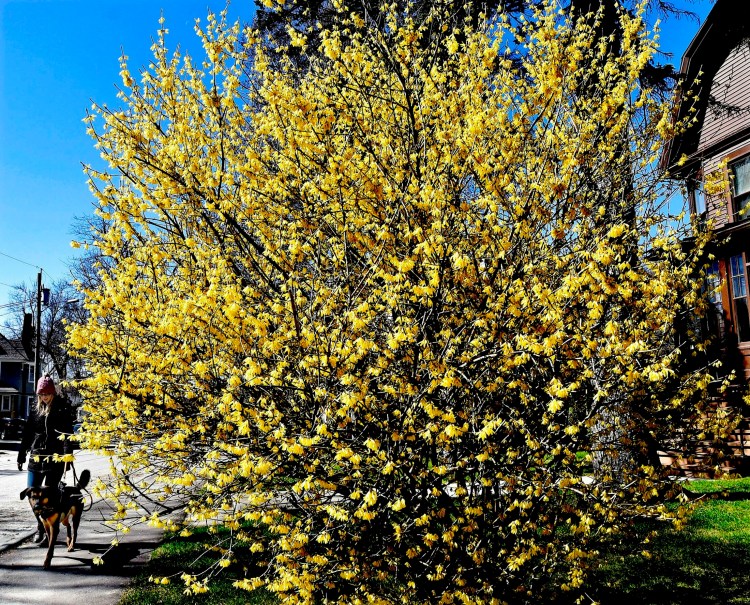The first question came on April 28, from a reader and the sister of a longtime co-worker. Why did her forsythias have blossoms on the bottom branches but none on the top? The following week, Caleb Goossen noted the same forsythia problem in a Maine Organic Farmers and Gardeners Association’s pest report.
We have only one forsythia, and it’s a dwarf, so I hadn’t noticed. But I knew the answer to the reader’s question because the same thing had happened about a decade ago. This winter, like that one, a string of warm late winter days caused the buds to start forming. Then the warm days were followed by a frigid weekend, with temperatures dipping to 7 below zero on the coast and even colder inland. Any buds that weren’t covered by leaves or by the little snow we had this winter froze, and subsequently failed to produce blossoms.
The bottom-blooming forsythia isn’t the only problem that late winter cold snap caused. We’ve had a similar issue with our PJM rhododendron, which we’ve had for about 15 years. It’s the only PJM we have, and I love it because it was free: Someone dropped it off at the town transfer station, and we rescued it. It had a neat root ball, so we brought it home and planted it. In southern Maine, all PJMs produce their double lavender flowers at the same time every May. You can tell it’s popular plant as you drive through residential neighborhoods – almost everyone has one or more. Ours bloomed on just one stem, which was slightly more protected from the wind. The remaining stems produced only tiny buds. I am hoping the rest of the shrub will be OK next year.

A peach tree in Tom Atwell’s garden in Cape Elizabeth was vibrant several summers ago. The tree has few blossoms or leaves this year, and Atwell is worried it was damaged by the February cold snap. Gregory Rec/Staff Photographer
I’m more worried about our Lars Anderson peach tree. Peaches are a stretch in Maine’s climate, and ours has looked beautiful for about five years, producing beautiful blossoms in May and wonderful-looking fruit in August or September. I’ve never had a harvest because every year just when the fruit looks great but is too hard to be considered ripe, some pest has taken all the fruit. I’m guessing raccoons, but other people have suggested teenagers. This year, I ‘d vowed to myself to harvest the crop early and let it ripen indoors. That point is moot. We’ve had no peach blossoms and very few sprouted leaves. I fear the tree will die.
Its death might be a solution to a different problem. Magnolias were beautiful this year. We’ve successfully grown the more shade-tolerant white Stellata magnolias, but lacked enough sun for pinkish-purple loebneri hybrids. One of those hybrids could end up replacing the peach tree.
Apples, thankfully, are hardier than peaches. Our older apple tree – we don’t know the variety and maybe it’s an unnamed seedling – has produced good crops for the past few years and the blossoms are healthy. Our Red Astrachan, which we purchased as a bare-root last year, has plenty of leaves and, surprisingly, one blossom. For at least the next two years, we will cut off any fruit that appears so that the sapling can put its energy into growing strong, not growing fruit.
Despite the cold snaps, most of our perennials and shrubs are doing well, and they bloomed earlier than normal. We were disappointed that the daffodils, while beautiful, blossomed for less time than usual. We blame the warmth and the wind.
For gardeners, the weather never seems to do what we want, or what we think our gardens need. But the plants probably know best. I think they are a lot smarter than I am.
Tom Atwell is a freelance writer gardening in Cape Elizabeth. He can be contacted at: tomatwell@me.com
Send questions/comments to the editors.



Success. Please wait for the page to reload. If the page does not reload within 5 seconds, please refresh the page.
Enter your email and password to access comments.
Hi, to comment on stories you must . This profile is in addition to your subscription and website login.
Already have a commenting profile? .
Invalid username/password.
Please check your email to confirm and complete your registration.
Only subscribers are eligible to post comments. Please subscribe or login first for digital access. Here’s why.
Use the form below to reset your password. When you've submitted your account email, we will send an email with a reset code.